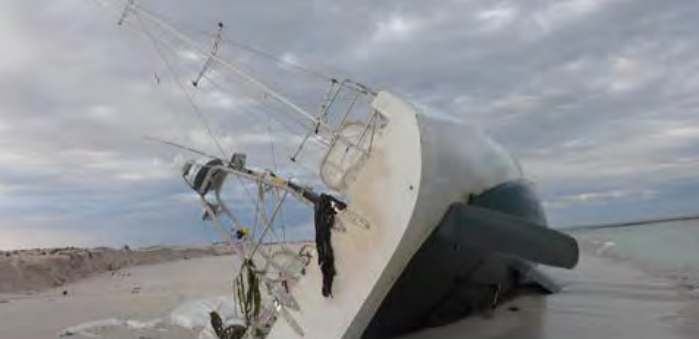In its latest Safety Digest, the UK MAIB describes a case of a yacht grounding during an ocean race. With respect to this incident, MAIB advised that every vessel sailing at sea needs a passage plan that has identified all potential hazards for the voyage ahead.
The incident
A large commercially operated yacht was taking part in an ocean race. There was a professional skipper in charge and the rest of the crew were amateur sailors, some of whom had previous sailing experience.
At the first day, shortly after the start, the fleet of yachts headed out to sea but needed to pass a headland before commencing the ocean crossing.
After dark, one of the yachts was sailing downwind with its mainsail and a spinnaker hoisted.
The yacht was on a heading that would take it safely past the headland and into the open sea.
However, over about an hour, the true wind backed by around 70 degrees.
To maintain the same relative wind direction and prevent a potentially dangerous accidental gybe, the crew made a succession of small alterations of course to port.
These course changes had the effect of driving the yacht unintentionally close inshore.
The skipper had been monitoring the situation and realised that the yacht needed to be turned away from danger.
However, soon after this turn was made, the yacht grounded and could not be freed.
There was a delay of nearly an hour in alerting the coastguard; however, once they had been alerted, all the yacht’s crew were rescued into lifeboats.
The yacht could not be salvaged and was cut up on the beach where it had grounded.
Lessons learned
- Every vessel, whatever its size or purpose, needs a passage plan that has identified all potential hazards for the voyage ahead. In this case, the skipper had intended to head away from land after the race start so was not planning to sail close to the shore. This meant that there was little expectation of having to manage coastal navigation. Nevertheless, the requirement to pass the headland meant that the passage plan should have assessed the risks of operating in shallow water.
- When things start to go wrong on a yacht when inshore, safe navigation must remain a high priority. The skipper was the only person closely monitoring the navigation. Unfortunately, when the situation started to deteriorate, the skipper was required to be on deck to supervise the crew handling and turning the yacht. This meant that no-one was monitoring the plotter at the navigation station down below, and there was no plotter on deck. As a result, no-one understood the immediate risk of grounding. It was also unhelpful that it was dark and hazy with an unlit foreshore, which meant that there were few visual clues to the close proximity to land.
- When properly set up, alarms can provide vital warning of danger. There were no navigational alarms set on the yacht; the electronic navigation system did not have safety depths set and, although the echo sounder was running, the audible shallow water alarm was turned off. The yacht was well-equipped with a suite of capable modern electronic safety equipment that could have helped to warn the crew of danger ahead.
- Any vessel in a distress situation should call for assistance as soon as possible. In this accident, the crew did not make an immediate “Mayday” or “Pan Pan” emergency call on VHF radio. Had this been done, it is highly likely that the local coastguard would have heard the call immediately and the crew could have been rescued earlier.




























































